U.S. Open Quick Hits
- FRACAS Favorites: Rory McIlroy, Justin Thomas, Jon Rahm
- Value Plays: Sam Burns, Shane Lowry, Billy Horschel
- First-Round Picks: Ryan Fox, Adri Arnaus
Just one month ago, Justin Thomas hefted the Wanamaker Trophy after beating Will Zalatoris in a playoff. Thomas was the No. 1 player in the world at the time, according to FRACAS.
He has since been supplanted, and we’ll be watching closely this week to see if the FRACAS world rankings can score back-to-back major championships with a win by his successor. With so much drama in the golf world, it’s refreshing to have a week that feels a little more normal with all the top players in the world competing at a major championship.
And so, the third major of 2022 is upon us, hosted by The Country Club in Brookline, Massachusetts. Read on, or watch here:
The Country Club has hosted numerous majors, most recently the 1988 U.S. Open won by Curtis Strange. It has been home to a handful of amateur championships and a Ryder Cup since then, but this will be the first professional stroke play tournament in Brookline in more than three decades. In that time the course has gone through a number of changes and will be played as a 7,312 yard par 70.
Without recent historical data on a course, we have to use some aggregated course stats for previous USGA setups to determine how the course will play. Over the last decade, U.S. Opens traditionally play about 2.5 strokes over par with a huge standard deviation of scores. The majority of holes are long and difficult par 4s, and there are always a few holes where scoring is possible.
This year, it looks as if the drivable par-4 fifth and the reachable par-5 eighth are two holes where players can put themselves in position to putt for eagle.
Course conditions will be something talked about throughout the week. The rough is as thick as can be, there are numerous blind tee shots, the greens are tiny, and steep-faced bunkers will make getting up and down a real challenge.
Looking at the weather projections from windfinder, there will also be consistent double-digit winds with gusts into the 20s. That’s not anything drastic, but with greens as small as they are, it will make things all the more challenging.
Below, the holes with the most variance are darker. So the darker holes are essentially the ones on which players have the greatest opportunities to distance themselves from the field – or lose plenty of ground in a hurry.
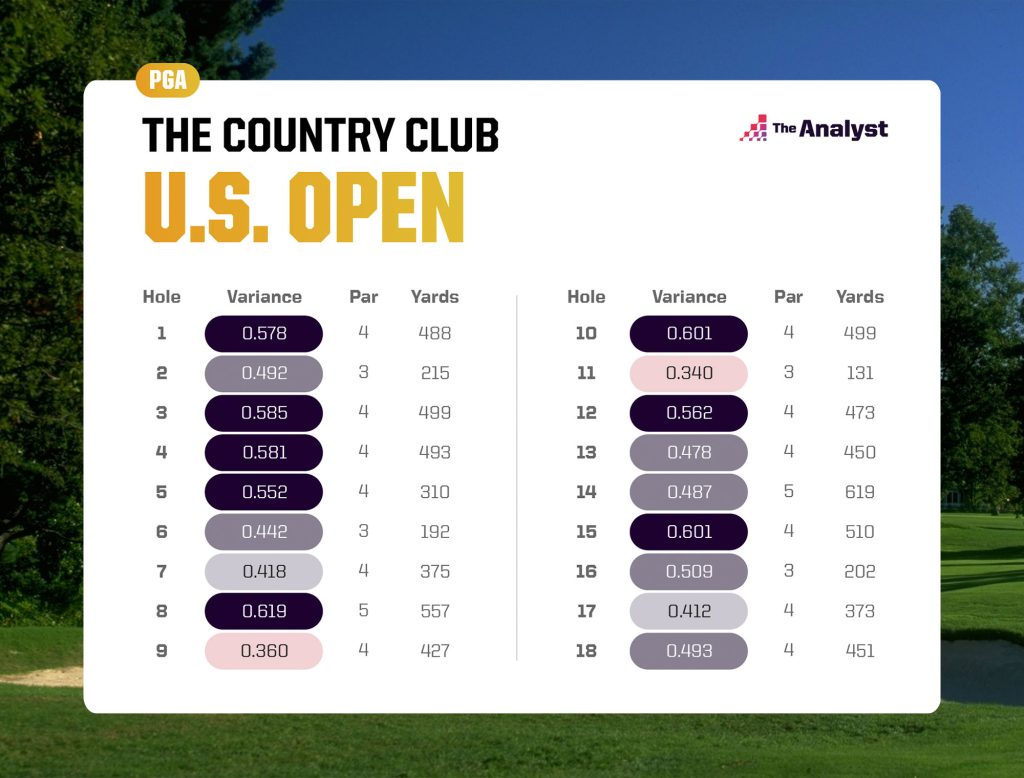
The FRACAS Picks
As is the case with all major championships, the field is strong. Only three of the FRACAS top 50 in the world are absent: Paul Casey due to medical reasons, while Matt Kuchar and Jason Day failed to qualify. It’s also noteworthy that the U.S. Open takes only the top 60 through the cut, including ties. It’s the toughest tournament on tour in terms of surviving the cut.
Because it’s an open championship with regional qualifying and worldwide qualifying through local tour wins, the back quarter of the field is not particularly strong. This shows in the average FRACAS for the field at 0.087 strokes below PGA Tour average. However, the median FRACAS for the field is 0.39 strokes above average. In other words, the field is very strong if you look at the top 125 or so.
As previously mentioned, our then top golfer in the world, Thomas, won the last major. This time, the top player in the world is Rory McIlory. He hit a relative low point just before the Masters, but a remarkable Sunday at Augusta led into some excellent form with finishes of fifth, eighth and 18th before winning last week at the Canadian Open.
As with most of the top golfers in the world, major championship setups offer excellent course fits. He’s gains about 20 yards off the tee against the field and has been on fire with his irons of late, gaining an average of over a stroke per round in his last four tournaments. It’s tough to win in a field like this, but McIlroy projects as the clear favorite with a 6.90% chance of winning.
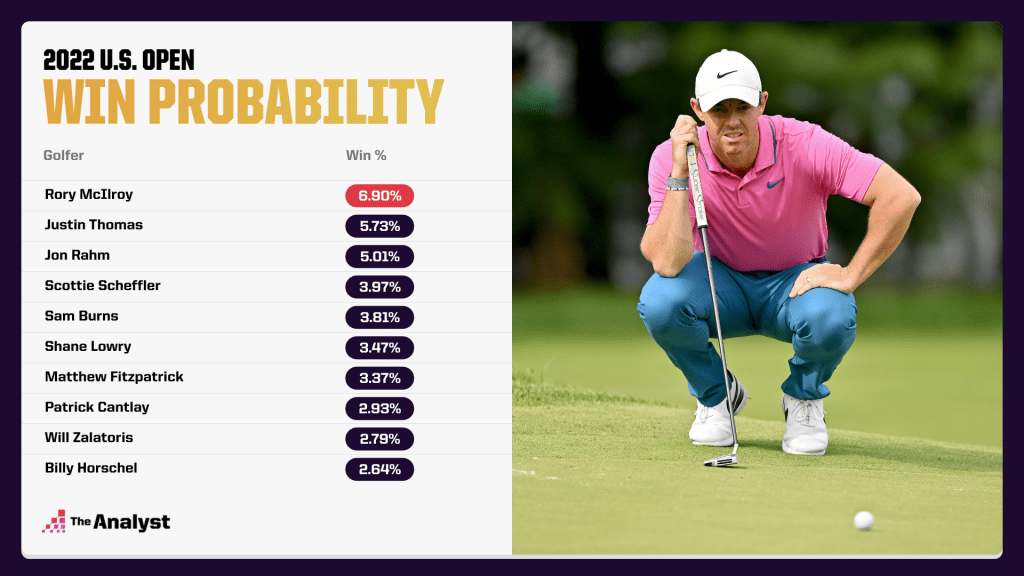
Second and third in our projections are the reigning major champion and the returning U.S. Open champion. McIlroy’s overtaking of Justin Thomas has much more to do with McIlroy’s performance than anything Thomas has done to drop in the rankings.
After a predictable letdown the week after winning a major, Thomas returned to form at the Canadian Open with a third-place finish. He’s only 0.08 strokes behind Rory in FRACAS, but McIlroy is a far more variable golfer, which explains the difference in modeled win percentage.
Jon Rahm looked a bit lost at the PGA Championship, but he finished strongly at the Memorial a couple of weeks later and is currently matching his long-term form with his current form. He’s not riding high, but any course with a focus on long and difficult is right up Rahm’s alley. Of the projected top 10, only Billy Horschel gets a bigger course suitability boost.
Current No. 1 player in the Official World Golf Rankings (OWGR) Scottie Scheffler comes in fourth by our model. While we’re not as low on him as we were at the PGA Championship (he missed the cut), Scheffler is once again dinged by the lack of par 5s. He’s so good at courses like Augusta where there are a good mix of scorable holes and difficult holes, but when a course is difficult from start to finish, he’s not quite as dominant.
Of the top 10, he has the lowest course suitability adjustment. Sam Burns is another golfer who doesn’t get a huge boost at this course, but his form is absolutely stellar at the moment. We’ll get to him and Shane Lowry in a bit.
Rounding out the top 10 are Matt Fitzpatrick, Patrick Cantlay, Will Zalatoris and Billy Horschel. With the exception of Cantlay, these are golfers who are a great fit for this course. Fitzpatrick, Zalatoris and Horschel all play their best when things are long and difficult.
A couple of big names not appearing in the top 10 are Cameron Smith, Collin Morikawa, Hideki Matsuyama, Xander Schauffele, Jordan Spieth, Dustin Johnson and Brooks Koepka. All of these players are either poor course fits (Smith, Schauffele, Spieth, Johnson, Koepka) or just aren’t playing their best golf right now (Johnson, Koepka).
Johnson appears on both lists and has been playing some pretty disappointing golf for a while now.
The FRACAS Value Plays
Currently, Sam Burns and Shane Lowry don’t technically qualify as value plays, as their modeled odds and consensus are pretty similar. But we’re including them because they are the relative favorites who might drift into value territory as the odds boards get a little softer.
Burns is currently sixth in the FRACAS worldwide rankings. He has four wins on the PGA Tour in the last two years and has not finished worse than tied for 26th in 2022 when he’s made the cut. Making the cut is the biggest hiccup for Burns. He’s missed five cuts in 12 starts this year, which doesn’t seem to fit the narrative of being the sixth-best player in the world.
Of those five cuts, only once did he lose more than a full stroke to the field. When he misses the cut, it’s usually on the number. Additionally, his ability to close on the weekends means he’s playing his best golf against a better field. Gaining more strokes on the weekend is weighted higher in FRACAS because you’re performing better against a better group of players.
In the Charles Schwab, which Burns won this year, the first and second rounds had a field strength of 0.21 strokes above PGA average. In the third and fourth rounds, when Burns shot 67-65, had a field strength of 0.53 strokes above PGA average. FRACAS sees Burns’ weekend performance as more impressive than someone who gained the same number of strokes over the first two days.
Burns has been slowly improving over the last few years, and he’s now one of the top players in the world. Our odds for Burns are about 27-1, and anything better than 30-1 in the market would be good value.
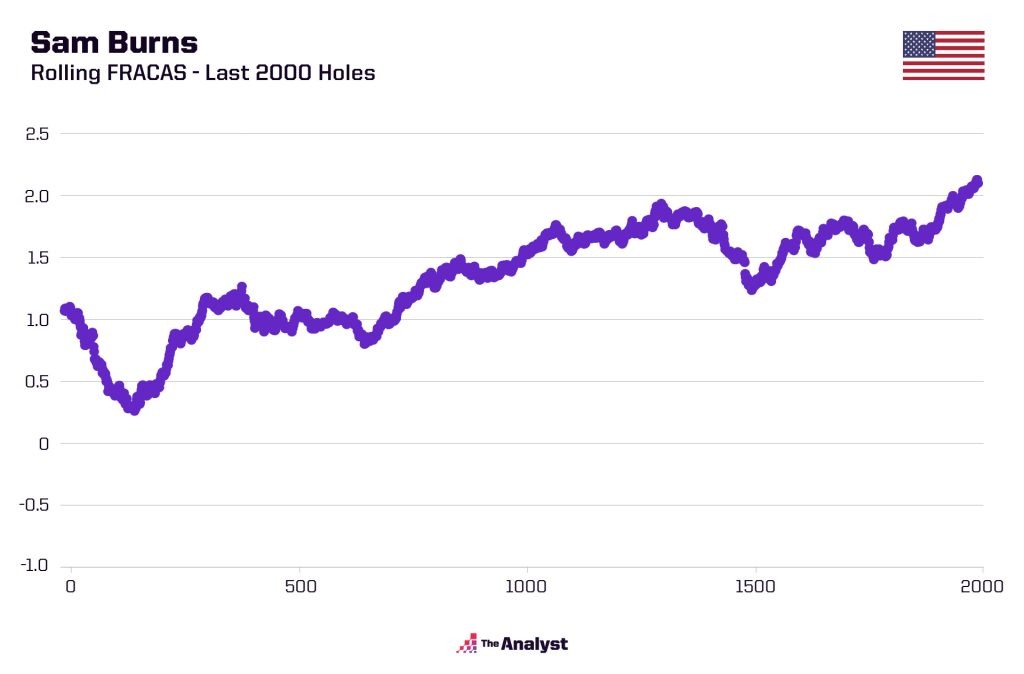
Lowry has shown similar improvements over the last couple of years. He’s been more consistent than Burns, and the improvement has come slower, but he now sits seventh in the FRACAS rankings. While the wins have remained elusive, it’s been a while since Lowry has come into a major this hot. The Country Club is a spectacular course fit for him as well, getting a boost of 0.267 strokes.
His outlook gets better the longer and more difficult a course plays, and that will be the test this week. We have Lowry at 29-1 to win this week and anything 33-1 or longer is an excellent value.
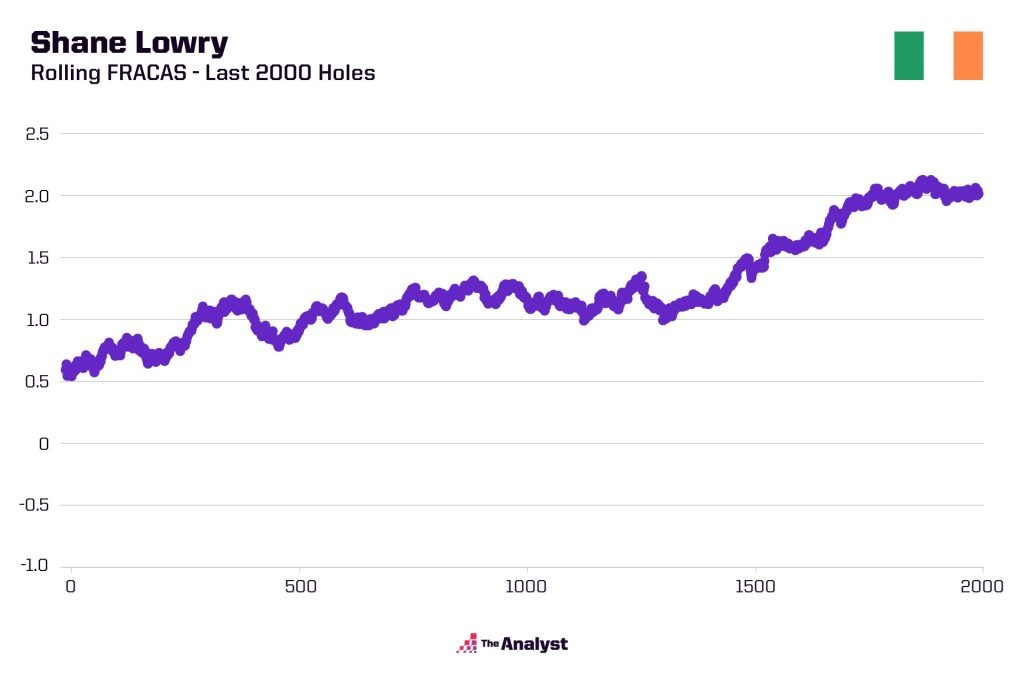
At the back end of the top 10 sits Billy Horschel, who we often mention here. His major championship results leave a lot to be desired, but his evolution over time has not gone unnoticed.
His around-the-green game in particular has grown leaps and bounds over the last couple of years. In his last 10 measured tournaments, he’s gained an average of 0.36 strokes per round around the green. In the 10 before that, he averaged minus-0.13 and in the 10 before that, he averaged minus-0.17. The result is high performance on the most difficult holes.
In this field, he’s behind only Rahm and Patrick Cantlay in projected scoring on long and difficult par 4s. It’s the right skill set to have at Brookline. We have Horschel at 38-1 to win this week, and the consensus is around 46-1. Strong value for Billy Ho.
Further down the board, we start seeing some placement values in Keegan Bradley and Russell Henley. Both golfers are excellent fits for this course and have shown an ability to succeed in major conditions. Both are also excellent ball strikers but poor putters.
However, with tiny greens this week the focus will be on hitting the greens in the first place, an area where the premium ball strikers will have an advantage. We have Bradley at 66-1 and Henley at 89-1 to win, which provides some small value over their consensus odds of 73-1 and 102-1, respectively. Where we see a bit more value is in the odds of each finishing in the top five. Bradley is listed at 12-1 and Henley at 18-1, but our model thinks those numbers should be 10-1 and 14-1.
There are some good values on PGA stalwarts Brian Harman, Tom Hoge, Sebastian Munoz and Troy Merritt, but we’d prefer to focus on a few DP World Tour regulars. Kiwi Ryan Fox has been on a stellar run over the last couple of months. Though he started 2022 with results of 61-26-MC, his results since read as 1-15-9-8-2-54-2. The 54th was the PGA Championship, where he was in the mix for top 20 before a final-round 77 sent him down the leaderboard.
It’s a positive course fit for Fox, who is about as long as McIlroy off the tee. Hitting fairways is always a struggle, but he does manage to parlay his distance into greens in regulation. His modeled odds to win are long at 126-1, but he’s worth a flier if you’re into longshots at 180-1 – especially if you can get 10 or so places to go with it.
His top-five odds can be found at 25-1 and our model likes that at a little shorter than 20-1. Our favorite Fox number this week is as a first -round leader. He’s an incredibly variable golfer and his 125-1 being offered is a great value over the 56-1 number our model spits out.
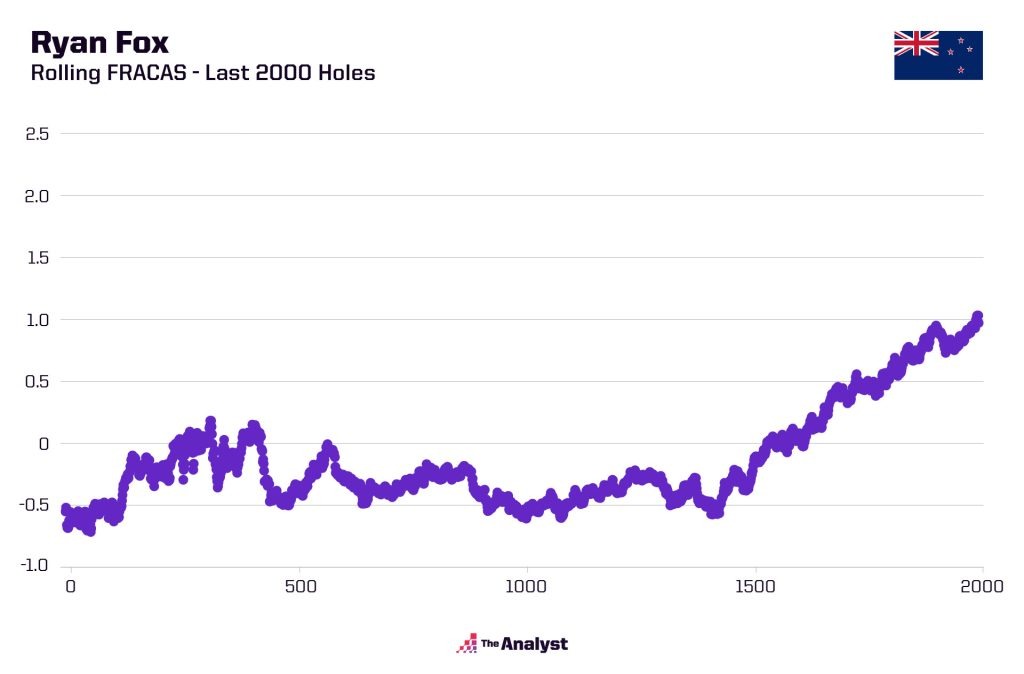
Another DP World Tour regular who’s a good flier for a first-round wager is Spaniard Adri Arnaus. He finally got his premiere tour win this year, taking the Catalunya Championship in early May. He played in the PGA Championship as well, finishing in a tie for 30th and gaining nearly five strokes off the tee.
Like Fox, he’s long off the tee, but perhaps a little more accurate. Though his putting is often dreadful, he shouldn’t have too many chances to putt his way out of the tournament on these tiny greens. He performs well when the course is long and difficult and is nearly as variable as Fox with his scoring.
It’s tough to see Arnaus winning this week, but a first-round leader at 150-1 or a top five at 35-1 is great value when our model has those numbers at 71-1 and 26-1.
Graphic design by Matt Sisneros.
Enjoy this? Subscribe to our mailing list to receive exclusive weekly content.
